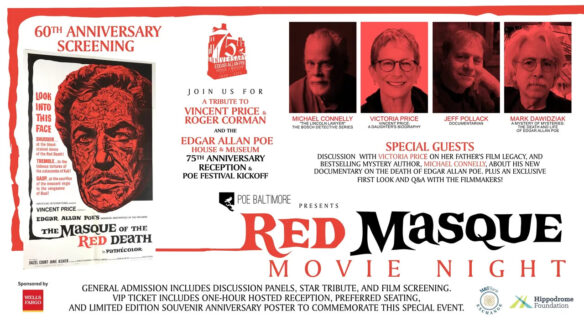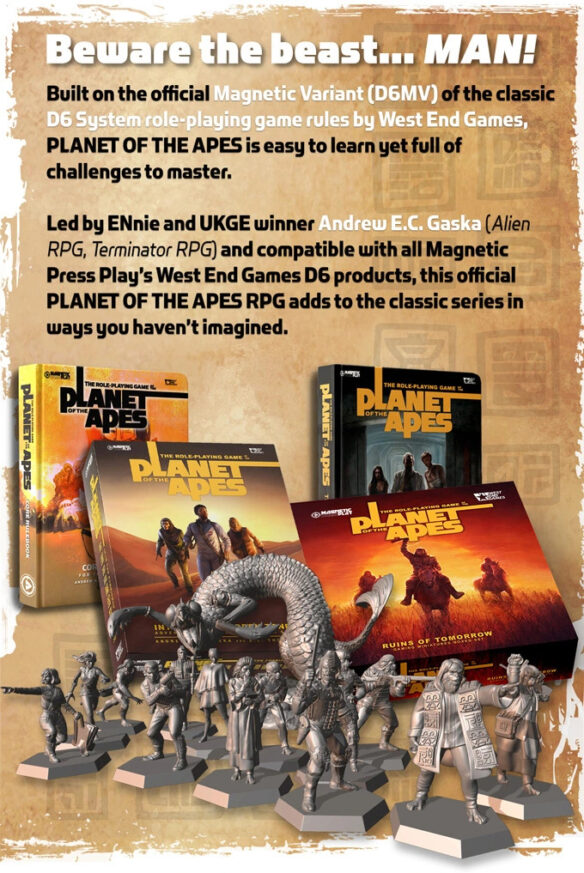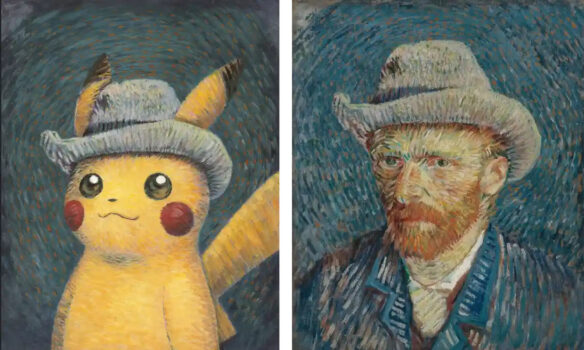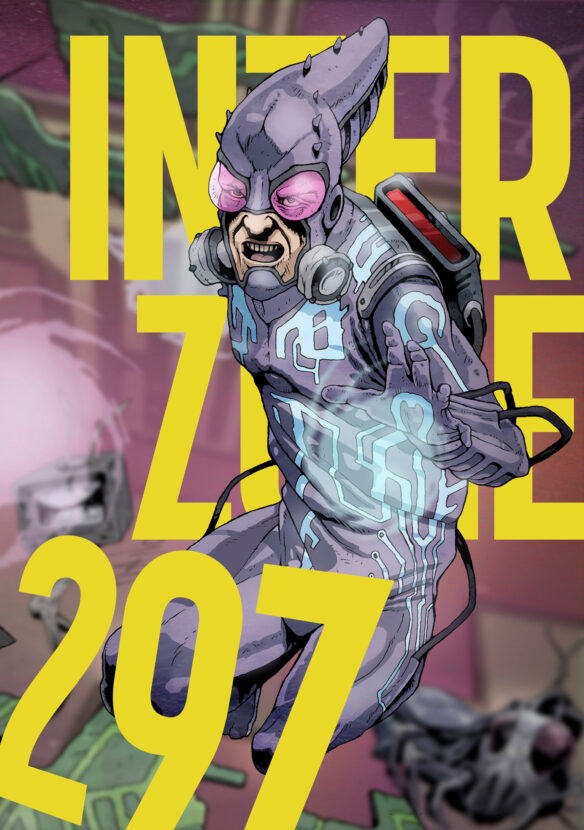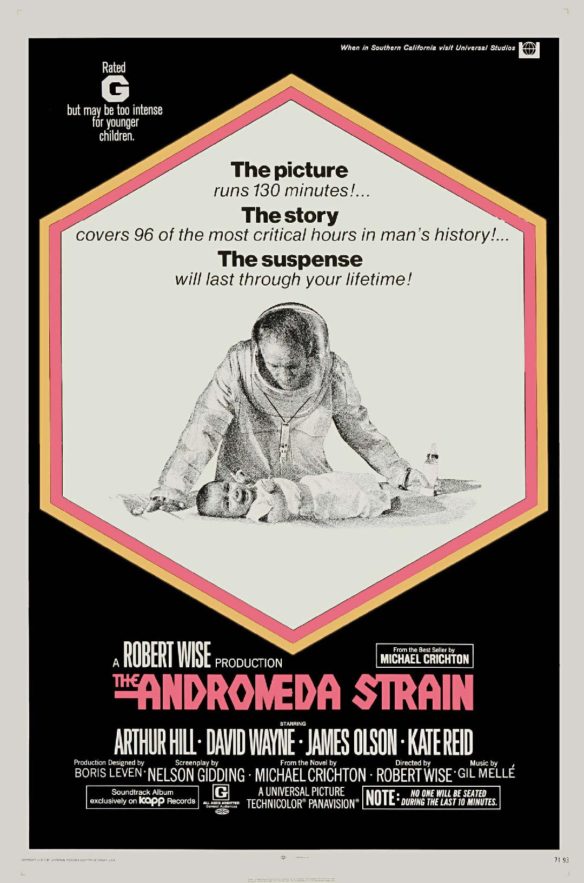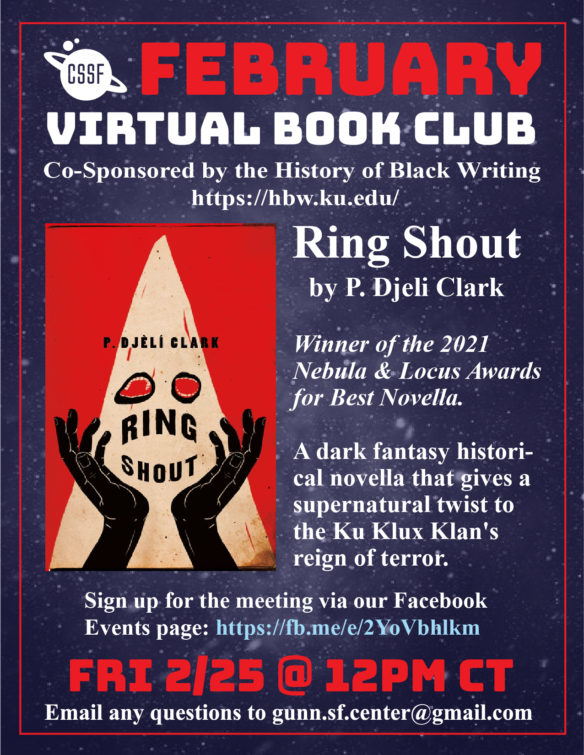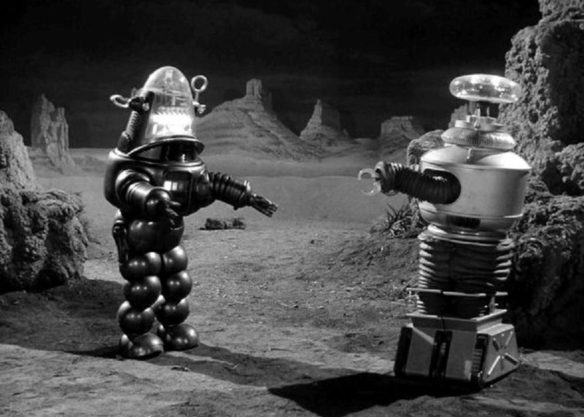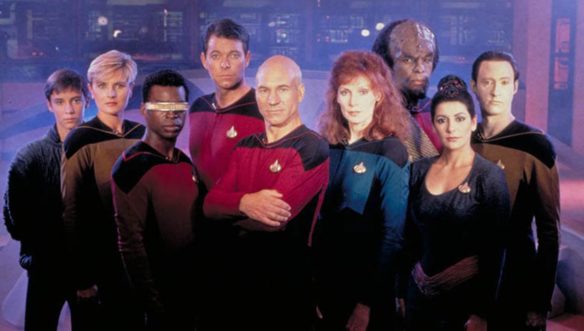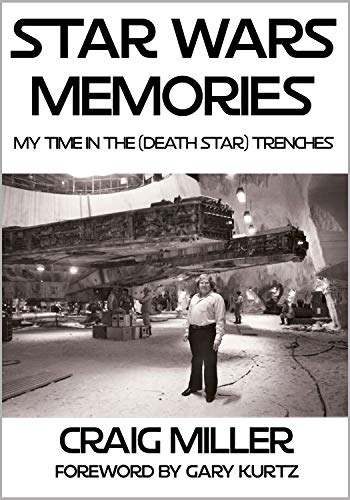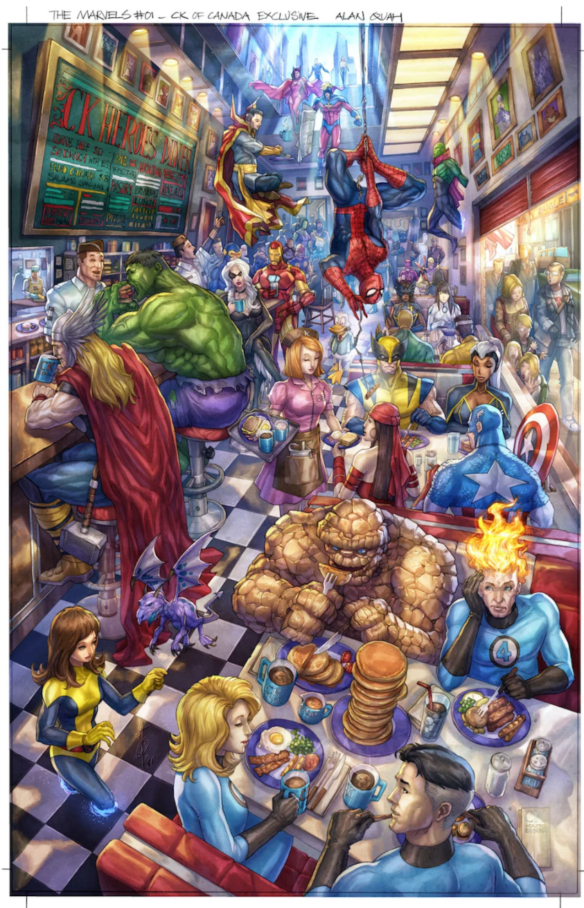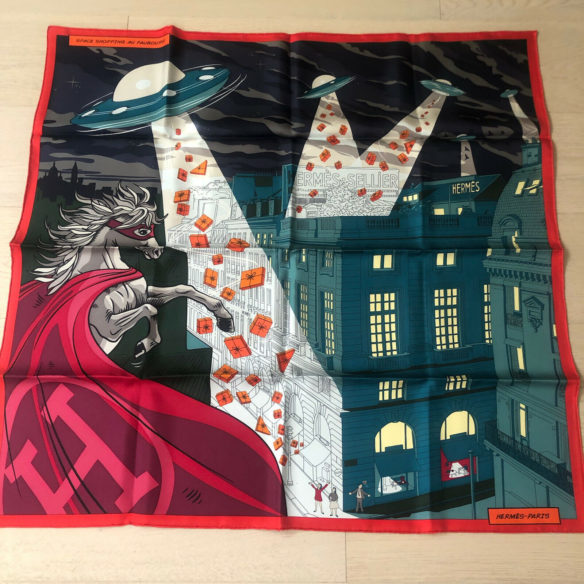(1) WHY NOT SAY WHAT HAPPENED? Episode 17 of Scott Edelman’s podcast Why Not Say What Happened? tells “How My Meeting Margaret Hamilton Became a Marvel Comics Contest”. Below is a photo of young Scott with the actress who formerly played the Wicked Witch but by the 1970s was hawking Maxwell House coffee.
Listen in as I look back half a century on what it was like being in the room with Len Wein and Dave Cockrum (or as much as I’m willing to admit) as they plotted Giant-Size X-Men #1, why my mid-’70s likeness still hangs on the wall at Marvel Comics HQ, my freelance income during the first six months of my life as a comics professional, the collaborative short stories my friends and I stayed awake 24 hours to write on Harlan Ellison’s 39th birthday, an article I commissioned for F.O.O.M. about collecting comics in 1975 which should make you weep 50 years later, how my meeting with Wicked Witch of the West Margaret Hamilton ended up being a Marvel Comics caption contest, and much more.
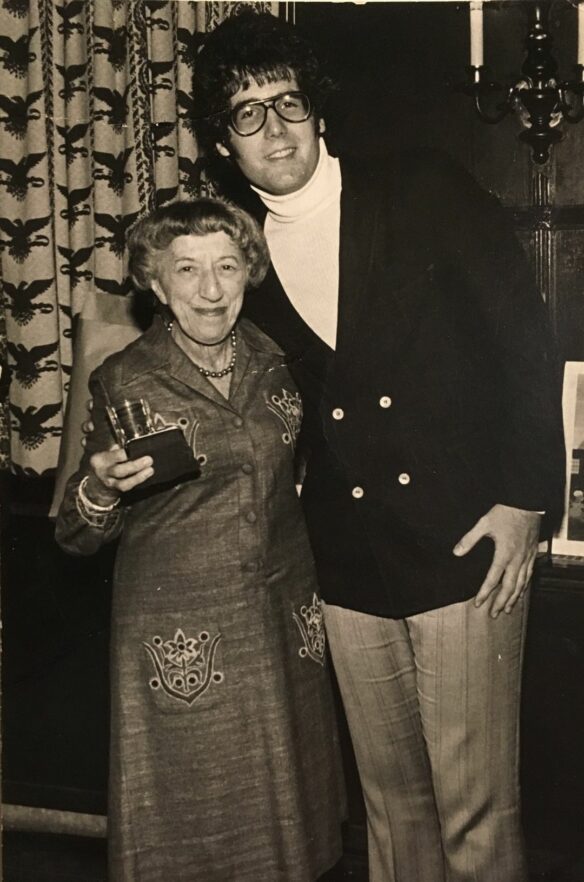
(2) I SOLEMNLY SWEAR I AM UP TO NO GOOD. “Goldfish Releases a New Harry Potter-Themed Butterbeer Flavor” and Food & Wine is agog. It will release in March.
Tired of having the same old snack? The you’re in luck. Goldfish has got something new for you, and it’s downright magical.
On Tuesday, Goldfish announced that it’s partnering with Warner Bros. Discovery Global Consumer Products to “cast a delicious spell” with the launch of its limited-edition Goldfish Butterbeer Flavored Grahams, which, yes, are inspired by Harry Potter.
The new crackers, the company noted in a statement provided to Food & Wine, come with a “rich butterscotch flavor, hints of creamy vanilla, and a touch of magic in each fun-shaped bite.”…
… Goldfish Butterbeer Flavored Grahams will be hitting grocery store shelves in March for about $3.69…

(3) THE PEASANTS ARE REVOLTING. “The ‘Pokémon TCG Pocket’ Trading System Is So Bad Players Are Revolting” reports WIRED.
PLAYERS OF THE game Pokémon Trading Card Game Pocket are in revolt over its newly introduced trading system. Since its release last week, fans across Reddit, X, YouTube, and even the game’s official site all agree: Trading in Pocket is very, very bad.
Pocket, which launched last October for iOS and Android, is a free-to-play adaptation of the physical card game that digitally streamlines card-collecting and battling. Mimicking the gotta-catch-’em-all hype that dominated the ’90s and early aughts, the game’s developers frequently drop new card sets to keep players tearing open digital packs in the hopes of getting rare Pokémon. Those cards can then be used to battle either solo against AI, or online against other players. Prior to last Wednesday, the one thing missing from the game was trading, which would allow players to swap cards and fill in their decks.
Now, players are threatening to cancel premium subscriptions—a $9.99-per-month membership with additional perks like extra items and cards—in response to the newly released feature. “Shame, it was really fun for a few months,” wrote a player in a post on Reddit where they encouraged others to cancel their subscriptions. “Now it feels gross.”…
(4) DIDN’T CANCEL, DONE ANYWAY. When a forever game is no longer forever: “I loved Pokémon Trading Card Pocket – until I didn’t” says the Guardian’s game columnist.
For months now I have been in the thrall of Pokémon Trading Card Pocket. It’s a devilishly slick blend of card-collecting and pared-down battling that has had me obediently opening the app on my phone at least twice a day since it launched. The virtual cards are beautifully done; the rare art cards especially, with their pastoral scenes of Pokémon in their natural habitats. I have spent many hours on the battles, too, honing decks and chasing win streaks to earn myself victory emblems. I got most of my friends into it, anticipating the day when its makers at DeNa would finally enable trading so I could fill the last couple of holes in my collection.
This week, on the day that the trading went live and an expansion full of pretty new cards was introduced, I quit. I made a couple of trades for the Venosaur Ex and Machamp Ex that had evaded my grasp despite opening hundreds of packs, took a screenshot of the “collection complete” screen, and I haven’t opened it since. I’m done….
(5) MOONSONGS. John Scalzi spotlights a little known challenge: “How Translation Works, Book Title Edition” at Whatever.
…The title of the Hungarian version of When the Moon Hits Your Eye is an example of this “translation, not transliteration” phenomenon. People in English-speaking countries know the title is a lyric from “That’s Amore,” a well-known standard most famously sung by Dean Martin. The title hits in a very specific way, because English-speaking folks have the context for the phrase and the song it’s embedded into. But it’s not a guarantee that the phrase hits the same way in other languages, or will have the same sense of play.
The solution Agave, my Hungarian publisher, and its translators, decided on: Change the title to Csak a hold az égen, which are lyrics in the 1995 song “Szállj el, kismadár,” which is the biggest hit from the biggest album of Republic, a well-known Hungarian band:
“Csak a hold az égen” translates to “Only the moon in the sky,” and it’s the first line of the chorus of the song — which is to say, the line everyone who is a fan of the band or the song will reflexively be able to sing. The song was a top ten hit in Hungary, and the album it was on was number one on the Hungarian charts for ten weeks….
(6) BUTLER’S COMMUNITIES. The Huntington Library has reposted andré m. carrington’s 2024 article “Octavia E. Butler in Community, Then and Now”.
…Butler herself traveled a long way, both figuratively and literally, to find community. When I teach Butler’s works in courses on science fiction and African American literature at the University of California, Riverside, I like to show my students two photographs that feature Butler in group settings. In the first, taken at a 1970 science fiction convention in Pittsburgh, Butler stands on the outer edge of a group of young writers with their mentor, the notable science fiction author Harlan Ellison, seated in front. Butler and her fellow students had just participated in a science fiction workshop at Clarion State College under Ellison’s guidance. The other students notably included Vonda McIntyre, a feminist science fiction pioneer who would become a lifelong friend to Butler; French linguist and science fiction writer Jean Mark Gawron; and Russell Bates, a Native American author from Oklahoma who would go on to write for television and film. Butler was the only Black participant in the workshop.
Years later, when Butler and author Samuel R. Delany were asked how many other Black science fiction writers there were, they responded, “We’re two-thirds.” The other forerunner was Charles Saunders, who pioneered the sword and soul subgenre, setting fantasy adventure stories in mythical settings drawn from African cultures. Having people like Delany, McIntyre, and Ellison as mentors and friends encouraged Butler to write meticulously researched, wildly imaginative, captivating novels that eventually made her the first science fiction author to win the MacArthur Foundation’s “genius grant.”
The other image I like to share with my students tells the rest of Butler’s story. In the photo above, she is by no means isolated: Her company consists of 28 Black women writers who attended a retreat convened by Essence magazine in 1988. Before the internet became the main source of news and entertainment, Essence—along with Ebony and Jet magazines—was a household name in 20th-century Black America. You couldn’t walk through a supermarket checkout line in a Black neighborhood without seeing its iconic covers. Black women have always been the target audience for Essence. Growing up, Butler saw women like herself and those far removed from her working-poor circumstances in its pages: celebrities, role models, and leaders. She saw that, as a Black woman, she could be one of them. And then, in 1988, there she was, appearing in Essence alongside economist Julianne Malveaux, playwright Ntozake Shange, and law professor Elaine Brown, former chair of the Black Panther Party.
Seeing Butler in these 1970 and 1988 photos in the company of different peers helps us understand how much we can learn from her example. She was unique, but she was never singular, the way we often think about intellectuals. She contained, as the poet Walt Whitman would have put it, “multitudes.”…
(7) THE BLACK FANTASTIC ONLINE PANEL. The Library of America will host an online event featuring Tananarive Due, Victor LaValle, Nana Kwame Adjei-Brenyah, and andré carrington, “The Black Fantastic: The New Wave of Afrofuturist Fiction Registration”, on Wednesday, February 19 from 6:00-7:00 p.m. Eastern. RSVP at the link. Contribution to attend: $5 (can be applied toward purchase of The Black Fantastic or any other book on the LOA Web Store.)

A new wave of science fiction and fantasy by Black writers has burst onto the American literary scene in recent decades: tales of cosmic travel, vampires, and alternate timelines set in profound social and psychological orbits. Building on the legacy of titans Octavia E. Butler and Samuel R. Delany, these visionary writers root their imagination of other worlds in the multilayered realities of Black history and experience.
Award-winning SF authors Tananarive Due, Victor LaValle, and Nana Kwame Adjei-Brenyah join andré carrington, editor of The Black Fantastic: 20 Afrofuturist Stories, for a conversation about genre, influence, and the fascinating and phantasmagoric universes conjured by these new voices on the vanguard of American fiction.
(8) MEMORY LANE.
[Written by Paul Weimer.]
February 5, 1956 — Invasion of the Body Snatchers (premiered on this date)
By Paul Weimer: The original, and possibly if not the best, in a dead heat with 1978’s Invasion of the Body Snatchers.
You know the story. Duplicates of people, created from alien seed pods (hence the phrase “pod people”) start replacing their originals in a small town in California. A small group of people band together to not only survive the menace, but to learn enough to escape and tell the authorities.
A classic, and for darned good reasons.
But why is it a classic? Excellent performances? The movie’s cast, from Kevin McCarthy as Dr. Miles Bennell, to Diana Wynter, King Donovan and Carolyn Jones are sharp and always on. You might not recognize them as A-listers or even B-Listers from the perspective of time, except maybe Carolyn Jones, who played the original Morticia Adsams in the Addams Family TV series. But they perform their roles here, and well. (Fun fact, the director Sam Peckinpah has a cameo).
Excellent editing? There are scenes of terror, suspense, and horror that are very well executed by director Don Siegel. It’s been aped and copied and referenced many times, not only in sequels to the movie, but in popular media and culture.
A stripped down and straight along plot and sequence of scenes that never lets up until the finale? The existential, political emotional horror of the whole idea of “pod people” in its original and most pure form? I saw the movie on WPIX in the late 70’s or early 80’s, and have seen it many times since. I didn’t get the political allegory one can make when I was younger…now, I see a number of potential political allegories one can read into it — anti-communism, the dangers of ultra-conformity, anti-McCarthyism. Any which way, it shows what happens to the individual, when society becomes poisoned and toxic (and doesn’t that feel relevant today).
I do find it interesting that thanks to the framing device, this is perhaps the most optimistic and “positive” of all of the Invasion movies. Every single one, especially 1978, has gone against this grain since, making the Invasion ever darker, ever more successful, humanity ever more doomed. Is it a sign of the times and tastes in movie fans? Or tastes in studio heads? I am not sure. But the movie does end as it began with Miles in the hospital, not only telling his story but being believed, and action being taken. I understand that the prologue and epilogue were later additions. I’ve never seen the film without them, I do wonder how I’d feel about a cut of the movie with both of them removed.
Maybe we do need an Invasion of the Body Snatchers in our own year of 2025 where people among us turn so violently and horribly against anyone who is different, where our political leaders are feckless, amoral, cowards or evil, and where it seems that research money is going into “18% Gray AI slop.” Meeting and facing an alien invasion, an insidious and carefully planned one. (Consider the scene where our heroes overhear Grivett’s plans for the organized dissemination of the Pods) . Pluck, luck, hard work and collective action oppose the Invaders. Even without the prologue and epilogue “assuring the happy ending” there is a sense of human spirit and resilience throughout the film.
The movie is a lean and mean 80 minutes long (barely longer than an extra length episode of a TV series season opener or finale these days). It never outstays its welcome, and in fact is probably underrated, if anything, as one of the more important movies ever made. Have you seen it lately?

(9) COMICS SECTION.
- Saturday Morning Breakfast Cereal complains about lengthy AI version names.
- Eek! updates the Oz story.
- Yaffle notes ancient cat history.
- Tom Gauld knows science is a team game.
(10) HORROR AND HOLLYWOOD ACCOUNTING. Inverse gets the filmmakers and cast to tell them “The Oral History of ‘In the Mouth of Madness,’ John Carpenter’s Misunderstood Cosmic Horror Masterpiece” (a 1995 movie).
…The film’s budget was initially reported to be $15 million, but New Line kept whittling it down. In various commentaries and interviews, Carpenter has pinned the final budget at anywhere from $7-10 million, a significant reduction. Notably, the film’s original ending had to be completely reimagined.
King Carpenter: [There was] fighting with the studio, but that’s every movie. They had some weird people. They don’t trust anybody, and at the same time, I don’t trust them, so it becomes like Spy vs. Spy. [The budget] kept changing as we got closer to shooting. It would be one amount, and then they would cut $2 million out of it. You’re just going, “Why?” But it is what it is, that’s what happens, so we’d roll with it. We just figured it out, and you figure out your shooting days, and you know going in that whatever you anticipate, something in there is going to go to sh*t, and so you have to be prepared to punt on something.
Greg Nicotero: I just remember being in pre-production and we would have all the meetings at this little house in Sherman Oaks that they had on Willis Avenue, and looking at all the storyboards for the finale, the original finale where the whole town gets sucked into the book at the end. And it was a big, big deal. And for us, the designs were coming up with not only the creature, but some of the other looks. And I remember we got to that ending and it was like, “We don’t have enough money to do that.” ILM had storyboarded the whole thing, and it was all this really, really elaborate big action sequence. And I remember being at the meeting where they went, “Yeah, we’re going to rewrite the ending because we don’t have the money to do that.” And I was like, “Oh.”…
(11) OVERDUE AT THE HERCULANEUM LIBRARY. “First glimpse inside burnt scroll after 2,000 years” says BBC.
A badly burnt scroll from the Roman town of Herculaneum has been digitally “unwrapped”, providing the first look inside for 2,000 years.
The document, which looks like a lump of charcoal, was charred by the volcanic eruption of Mount Vesuvius in 79AD and is too fragile to ever be physically opened.
But now scientists have used a combination of X-ray imaging and artificial intelligence to virtually unfurl it, revealing rows and columns of text….
…Inside this huge machine, which is called a synchrotron, electrons are accelerated to almost the speed of light to produce a powerful X-ray beam that can probe the scroll without damaging it.
“It can see things on the scale of a few thousandths of a millimetre,” explained Adrian Mancuso, director of physical sciences at Diamond.
The scan is used to create a 3D reconstruction, then the layers inside the scroll – it contains about 10m of papyrus – have to be identified.
“We have to work out which layer is different from the next layer so we can unroll that digitally,” said Dr Mancuso.
After that artificial intelligence is used to detect the ink. It’s easier said than done – both the papyrus and ink are made from carbon and they’re almost indistinguishable from each other.
So the AI hunts for the tiniest signals that ink might be there, then this ink is painted on digitally, bringing the letters to light….
… Last year, a Vesuvius Challenge team managed to read about 5% of another Herculaneum scroll.
Its subject was Greek Epicurean philosophy, which teaches that fulfilment can be found through the pleasure of everyday things.
The Bodleian’s scroll is likely to be on the same subject – but the Vesuvius team is calling for more human and computing ingenuity to see if this is the case….
(12) BUCKET OF BLOOD. “The Monkey Has A Popcorn Bucket, And It Is An Absolute Must For My Stephen King Collection” says a CineBlend contributor.
…For those of you haven’t been paying attention, the titular evil in The Monkey (and what the popcorn bucket is modeled after) is an evil wind-up toy that kills a person whenever the key in its back is turned. In the Stephen King short story on which the movie is based, the cursed object is a classic cymbal-banging monkey, but the design was changed up for the film due to rights issues. Instead of clashing cymbals, it holds a pair of drumsticks and beats a snare that it holds between its legs.
The film centers on a pair of twin brothers who discover the monkey in the closest of their absconded father. After the vicious toy rips through their family like tissue paper, they are able to successfully contain it for a while, but years later, when the siblings are estranged adults, it makes a horrible return.
The popcorn bucket’s likeness to the prop in the movie is impressive… but if fans really want to go the extra mile, they’ll plan ahead and bring some red food dye with them to their screening of The Monkey to apply it to the contents before they start munching. After all, part of what makes the upcoming horror film so special is the fact that it has a good shot of going down in history as the goriest Stephen King adaptation, which is an aspect well-highlighted in the trailers and previews….
According to Nerdist: “It will only be available at AMC Theatres locations, and it comes with a large popcorn for $44.99 plus tax. The 85-ounce popcorn bucket is stylized to look just like the monkey toy that’s at the heart of the film.”
(13) IN A HOLE IN THE GROUND. “Archaeologists Unearth Rare 1,000-Year-Old Food Storage Pit in Alaska” – Smithsonian has details.
On a hill of birch and spruce overlooking the Knik Arm, a narrow stretch of the Gulf of Alaska that extends northwest of Anchorage, archaeologists have unearthed a remarkably intact cache pit used by the region’s Indigenous Dene people. The discovery is offering a new perspective on the long human history of the region, as well as how to preserve and protect its legacy for generations to come.
Cache pits are like root cellars, as Elizabeth Ortiz, an archaeologist and cultural resource manager at Joint Base Elmendorf-Richardson (JBER), the military complex where the discovery was made, says in a statement.
Located along a well-known Dene trail that led north out of the modern-day Anchorage area, the pit measures about 3.5 feet deep. It was dug into well-drained soil and lined with birch bark and grass, which preserved fish, meat and berries through the harsh seasonal extremes of southeastern Alaska.
The Dene, also known as Athabaskans, include the Dena’ina and Ahtna people. In the summers, they would have stayed in the area to catch and preserve salmon and terrestrial meat, with houses and smokehouses lining the bluffs above the Cook Inlet, according to Arkeonews.
Archaeologists expected the cache pit to be a few hundred years old. However, radiocarbon testing revealed that it was actually much older.
“When we got the results back that said it was 960 years, plus or minus 30, we were shocked,” Ortiz tells Alena Naiden of KNBA, a local radio station. “[We] were jumping up and down in our cube in tears. It was very, very exciting.”
(14) VIDEO OF THE DAY. Ryan George takes us inside the “Back to the Future Part II Pitch Meeting”.
[Thanks to Cat Eldridge, SF Concatenation’s Jonathan Cowie, Steven French, Kathy Sullivan, Teddy Harvia, Mike Kennedy, Andrew Porter, John King Tarpinian, and Chris Barkley for some of these stories. Title credit belongs to File 770 contributing editor of the day Cat Eldridge.]


